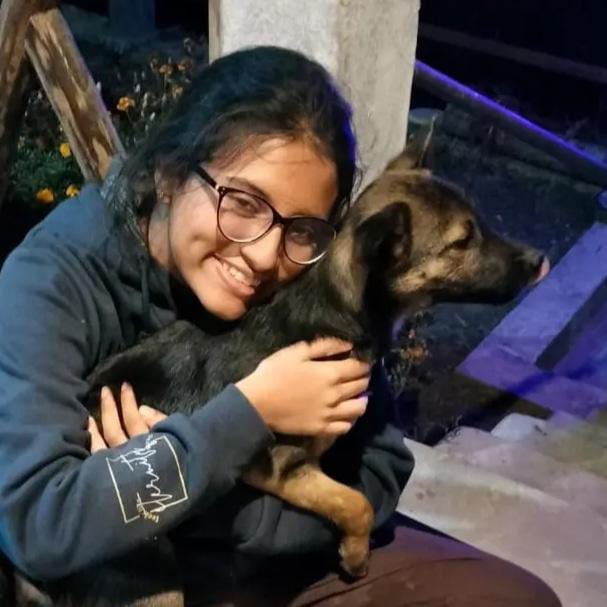 Hey, I’m Adrika, a third-year undergrad at IISER Kolkata. I am majoring in Biology and minoring in Physics. I like behavioral neurobiology, modelling different systems, and studying how behavior changes with context to learning and social interaction. Currently, I work with Drosophila melanogaster in Dr. Mohit Prasad’s Lab, and my project deals with post mating responses in mated females. I have also developed a simulation modelling border cell migration (I hope to write more about my projects some day), and am currently working on a theoretical ecology project as well.
Hey, I’m Adrika, a third-year undergrad at IISER Kolkata. I am majoring in Biology and minoring in Physics. I like behavioral neurobiology, modelling different systems, and studying how behavior changes with context to learning and social interaction. Currently, I work with Drosophila melanogaster in Dr. Mohit Prasad’s Lab, and my project deals with post mating responses in mated females. I have also developed a simulation modelling border cell migration (I hope to write more about my projects some day), and am currently working on a theoretical ecology project as well.
I have also recently started dabbling in Philosphy as well, though I do not know enough to comment about it. I enjoy discussing philosophy with some friends I have come across.
In my free time, I like hiking, birdwatching, literature, and cooking. I enjoy writing about things I come across.
Thanks for dropping by!
What is migration? The conversion of stationary epithelial cells into migratory, invasive cells, which is important for normal embryonic development. How do cells achieve this? Cells that are part of a stable epithelium lose their cell-cell and cell-matrix junctions that hold them together and acquire a less rigidly polarised morphology and break away from their neighbours.
Forward genetic analysis This involves uncovering the genetic basis behind a particular phenotype. Mutant lines are screened for specific defects in the process of interest. Molecular, cellular and chemical characterisation of the affected genes and proteins is then carried out. Reverse genetics: manipulating genes and studying their effect on phenotypes
...
The Sex Peptide in Drosophila melanogaster melSP is a component of the seminal fluid that induces post mating responses in Drosophila females. It is gradually released by proteolytic cleavage and induces several long-term postmating responses What does this entail? SP acts on internal sensory neurons expressing pickpocket(ppk). These then induce PMR.
Classic Post Mating responses elevated egg-laying
reluctance to further mating
altered dietary preference(high protein:carbohydrate interference) - (testing nutrient deficient flies by activating this group of neurons?)
...
Subject - The Plains Cupid (Luthrodes pandava)
Long afternoon walks are the best thing to happen to raccoon-eyed college students who have taken to living in the library. Especially if you are intercepted by these pretty sights; they flit about in the bushes, and dance nimbly on the slender stalks of coatbuttons, and overall, make a torrid summer more bearable.
A male wet season brood
These butterflies belong to the Lycaenidae family (tribe Polyommatini) of butterflies, (the second-largest family of butterflies behind Nymphalidae, or the brush footed butterflies), whose members are called gossamer-winged butterflies.
...
As far as behavior is concerned, it primarily is a response that an animal comes up with as a result of some stimulus. Neurothologists look at this phenomenon somewhat mechanistically - with an aim to unromanticise (?) it, trying to understand how eactly the central nervous system controls an animal’s response to their environment. We are supposed to concern ourselves with rather simple behaviours - sadly, the conceptual, and the technical difficulties one would have to undergo to deal with something more complex, is quite huge.
...
Neural Mechanisms of Behavior Now that we have established the foundation of neuroethology, let’s dive deeper into the neural mechanisms that control behavior.
The Neural Basis of Behavior Every behavior—whether as simple as a reflex or as complex as decision-making—arises from neuronal circuits. Neuroethologists investigate:
Sensory Processing – How animals perceive stimuli. Neural Integration – How sensory information is processed and transformed into a response. Motor Output – How the nervous system generates movement. These steps define an input-processing-output framework:
...
Living in a college on the outskirts of acres of farmland and dense shrubbery might be a bit boring, but it has its perks. I came across this one in front of my room.
The Indian Common Clubtail dragonfly, Ictinogomphus rapax, is found all over India. It’s a large yellow and black coloured dragonfly with bluish-grey ommatidia.
The name refers to the club-like widening of the end of the abdomen (abdominal segments 7 through 9). However, this club is usually less pronounced in females and is entirely absent in some species.
...
 Hey, I’m Adrika, a third-year undergrad at IISER Kolkata. I am majoring in Biology and minoring in Physics. I like behavioral neurobiology, modelling different systems, and studying how behavior changes with context to learning and social interaction. Currently, I work with Drosophila melanogaster in Dr. Mohit Prasad’s Lab, and my project deals with post mating responses in mated females. I have also developed a simulation modelling border cell migration (I hope to write more about my projects some day), and am currently working on a theoretical ecology project as well.
Hey, I’m Adrika, a third-year undergrad at IISER Kolkata. I am majoring in Biology and minoring in Physics. I like behavioral neurobiology, modelling different systems, and studying how behavior changes with context to learning and social interaction. Currently, I work with Drosophila melanogaster in Dr. Mohit Prasad’s Lab, and my project deals with post mating responses in mated females. I have also developed a simulation modelling border cell migration (I hope to write more about my projects some day), and am currently working on a theoretical ecology project as well.